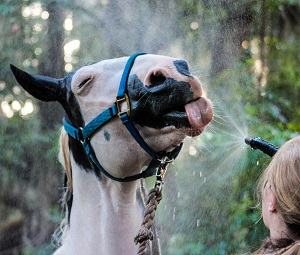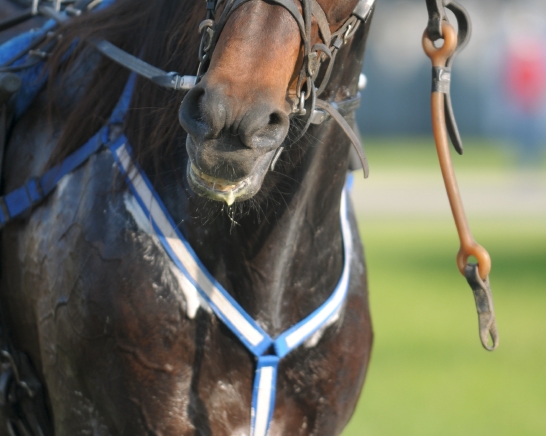 As summer approaches, days get longer, the weather gets warmer and people look forward to horseback riding – maybe even going for a ride on the beach. Yet, for some horse owners, summers are synonymous to despair. Those who have anhidrotic horses, or which the sweating ability seems to shut down during hot or humid days, are desperately trying to keep their horses cool, comfortable, and alive. However, unfortunately for some, that situation happens all year long. So, what causes horses to stop sweating and why is sweating so important?
As summer approaches, days get longer, the weather gets warmer and people look forward to horseback riding – maybe even going for a ride on the beach. Yet, for some horse owners, summers are synonymous to despair. Those who have anhidrotic horses, or which the sweating ability seems to shut down during hot or humid days, are desperately trying to keep their horses cool, comfortable, and alive. However, unfortunately for some, that situation happens all year long. So, what causes horses to stop sweating and why is sweating so important?
Researchers have been looking into this question ever since anhidrosis (the scientific term for “lack of sweat response”) was first reported in horses imported to Malaysia, over 90 years ago (1). As humans and one species of monkeys, horses primarily rely on evaporation of whole body sweat to control their internal temperature – called thermoregulation (2). In horses, some of the signs of anhidrosis include dry coat, difficulty breathing (flared nostrils), reduced appetite, decreased water intake and local hair loss (3, 4). This thermoregulatory ability is crucial for survival, as overheating can ultimately lead to convulsions, heat shock and death (5). While some humans are affected by anhidrosis, it is generally linked to other genetic conditions as Cystic Fibrosis and Congenital Insensitivity to Pain with Anhidrosis (CIPA) (6, 7). Yet, for horses, we are now beginning to understand the molecular mechanisms of impaired sweat response and their outcomes.
An epidemiological study analyzing 2,444 horses discovered that the risk for anhidrosis varies by breed, with Thoroughbreds (TB) and Warmbloods at higher risk. It was also observed that the odds are 21.67 times higher in horses with a family history of anhidrosis, highlighting a strong underlying genetic component to this disease (8). These findings supported the hypothesis of a genetic component involved in equine anhidrosis. With this knowledge, a new step on the research of anhidrosis in the horse by evaluating genetic components begun at the Brooks Equine Genetics Lab - University of Florida.
One of the major issues of such research is to determine the “type of anhidrosis”, as several factors can lead to non-sweating. For example, inadequate conditioning for the required level of physical performance, especially in hot and humid ambient conditions, often leads to an exhaustion of thermoregulatory mechanisms and acute anhidrosis/temporary hypohidrosis (9). Horses competing in hot, tropical climates are at higher risk of these conditions, yet both chronic and acute anhidrosis are frequently recognized in many non-tropical regions, especially temperate climates with the sudden onset of hot and humid summers (10-12).  Temporary anhidrosis can result from administration of drugs like macrolide antibiotics and antihistamines, although this condition usually resolves in a matter of days or weeks (13). In contrast, chronic idiopathic anhidrosis (CIA) occurs in more than one consecutive summer season and does not resolve despite changes in housing, diet and exercise schedule (8).
Temporary anhidrosis can result from administration of drugs like macrolide antibiotics and antihistamines, although this condition usually resolves in a matter of days or weeks (13). In contrast, chronic idiopathic anhidrosis (CIA) occurs in more than one consecutive summer season and does not resolve despite changes in housing, diet and exercise schedule (8).
Thus, through genomics tools, we delved into the factors that distinguish acute but reversible anhidrosis from permanent loss of sweat gland function. This pioneering study has already pinpointed a fundamental hypothesis into the pathogeny of CIA. A genetic mutation of an ion channel-component, leading to a defect of the ion channel, seems to be one of the key causatives of CIA. Interestingly, this finding agrees with previously published research on histopathology and physiology of chronic anhidrosis in the horse. While sweat glands of acutely anhidrotic horses appear structurally normal, suggesting a transient or functional defect rather than a cellular structural change (14, 15), CIA may be attributable to the loss of up to 50% of sweat glands to gradual, yet irreversible damage (16, 17).
By better understanding the molecular basis of sweat ability on the horse, we can develop target treatments that resolve or at least ameliorate CIA. While a diverse collection of medical treatments are often applied for equine anhidrosis; most are based on anecdotal reports and uncontrolled and unreplicated studies in small numbers of horses (18). Owners and clinicians frequently turn to dietary supplements, electrolytes, methyldopa, clenbuterol, and thyroid supplementation, to name just a few attempted therapies. Alternative therapies like acupuncture are also popular, though in at least one report acupuncture and herbal supplements were specifically shown to be ineffective (19). Still, to date, no treatment for anhidrosis has passed even the lowest standard for evidence-based medicine. This first step into researching the genetics of equine anhidrosis will surely pave the way for better treatments and further research to help our equine friends.
_______________________________________________________________________________________________
References:
- Evans CL, Ross KA, Smith DFG, Weilmalherbe H. A PHYSIOLOGICAL EXPLANATION OF EQUINE TROPICAL ANHIDROSIS. Journal of Physiology-London. 1957;135(3):P41-P2.
- Robertshaw D. SWEAT AND HEAT-EXCHANGE IN MAN AND OTHER MAMMALS. Journal of Human Evolution. 1985;14(1):63-73.
- Currie AK, Seager SWJ. ANHIDROSIS. Proceedings of the Annual Convention of the American Association of Equine Practitioners. 1976;22(NOV-D):249-51.
- Geor RJ, McCutcheon LJ. Thermoregulation and clinical disorders associated with exercise and heat stress. Compendium on Continuing Education for the Practicing Veterinarian. 1996;18(4):436-&.
- Warner A, Mayhew I. Equine anhidrosis: A review of pathophysiologic mechanisms. Veterinary Research Communications. 1983;6(1):249-64.
- Bernstein ML, McCusker MM, Grant-Kels JM. Cutaneous Manifestations of Cystic Fibrosis. Pediatric Dermatology. 2008;25(2):150-7.
- Indo Y. Nerve growth factor and the physiology of pain: lessons from congenital insensitivity to pain with anhidrosis. Clinical genetics. 2012;82(4):341-50.
- Johnson EB, MacKay RJ, Hernandez JA. An epidemiologic study of anhidrosis in horses in Florida. Javma-Journal of the American Veterinary Medical Association. 2010;236(10):1091-7.
- Geor RJ, McCutcheon LJ. Thermoregulatory adaptations associated with training and heat acclimation. Veterinary Clinics of North America-Equine Practice. 1998;14(1):97-+.
- Hodgson DR, Davis RE, McConaghy FF. Thermoregulation in the horse in response to exercise. British Veterinary Journal. 1994;150(3):219-35.
- Warner AE, Mayhew IG. EQUINE ANHIDROSIS - A SURVEY OF AFFECTED HORSES IN FLORIDA. Journal of the American Veterinary Medical Association. 1982;180(6):627-9.
- Warner A, Mayhew IG. EQUINE ANHIDROSIS - A REVIEW OF PATHOPHYSIOLOGIC MECHANISMS. Veterinary Research Communications. 1983;6(4):249-64.
- Stieler AL, Sanchez LC, Mallicote MF, Martabano BB, Burrow JA, MacKay RJ. Macrolide‐induced hyperthermia in foals: Role of impaired sweat responses. Equine veterinary journal. 2015.
- Peter JE, Boge P, Morris PG, Gordon BJ. ANHIDROSIS IN A THOROUGHBRED. Veterinary Medicine & Small Animal Clinician. 1981;76(5):730-2.
- Evans CL, Nisbet AM, Ross KA. A histological study of the sweat glands of normal and dry-coated horses. Journal of Comparative Pathology and Therapeutics. 1957;67:397IN45-405IN47.
- Jenkinson DM, Montgomery I, Elder HY, Mason DK, Collins EA, Snow DH. Ultrastructural variations in the sweat glands of anhidrotic horses. Equine veterinary journal. 1985;17(4):287-91.
- Jenkinson DM, Elder HY, Bovell DL. Equine sweating and anhidrosis Part 2: anhidrosis. Veterinary Dermatology. 2007;18(1):2-11.
- MacKay RJ, Mallicote M, Hernandez JA, Craft WF, Conway JA. A review of anhidrosis in horses. Equine Veterinary Education. 2015;27(4):192-9.
- Mallicote MF, Medina CI, Xie H, et al., editors. Acupuncture and herbal medicine used for treatment of anhidrosis. 2013: WILEY-BLACKWELL 111 RIVER ST, HOBOKEN 07030-5774, NJ USA.


Log in to join the conversation.